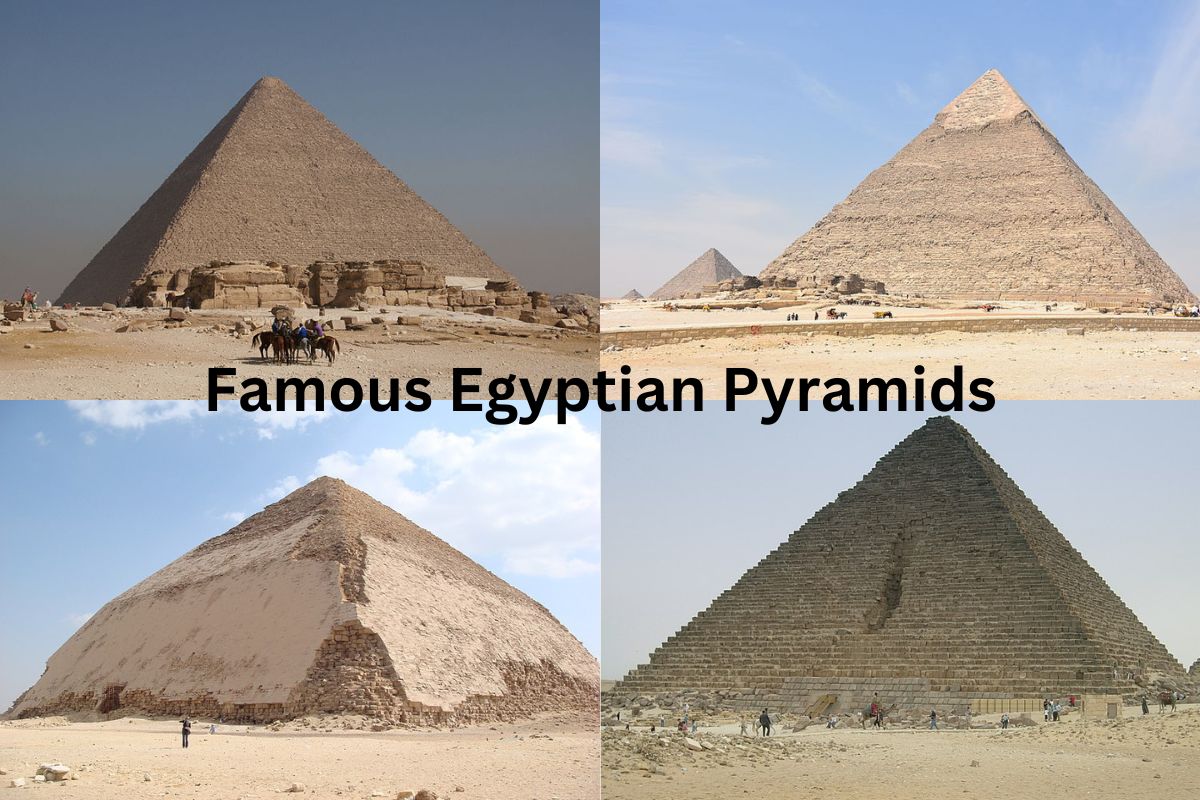The Egyptian pyramids are one of the world’s most recognizable architectural landmarks, noted for their massive size, exquisite design, and the mysteries surrounding its construction.
The pyramids were constructed as tombs for the pharaohs and their consorts, with the intention of protecting the pharaoh’s body and valuables for all eternity.
Several pyramids, varied in size and complexity, were built around Egypt over the millennia. Among these, the Great Pyramid of Giza, the earliest pyramid, the Pyramid of Djoser, and the Pyramid of Khafre have become world-renowned for their magnificence.
Each pyramid has its own history, design, and cultural importance, making it one of the world’s most fascinating landmarks.
Despite their impressive size and construction, pyramids were not immune to looting. Many were robbed of their treasures in ancient times, and some were even dismantled and used as building materials for other structures.
Today, only a handful of pyramids remain intact, with the Great Pyramid of Giza being the most famous and well-preserved.
Famous Egyptian Pyramids
1. Great Pyramid of Giza
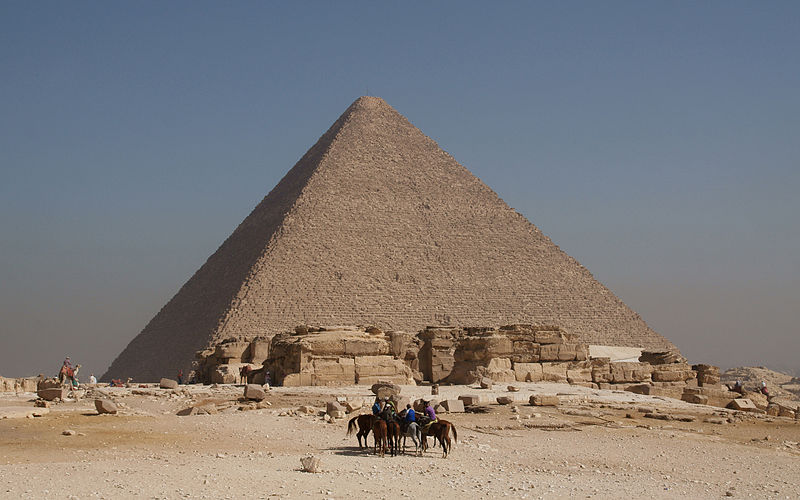
The Great Pyramid of Giza, also known as the Pyramid of Khufu, is Egypt’s largest and most well-known pyramid. It is one of the Seven Wonders of the Ancient World and is located in Giza, on the outskirts of Cairo.
It was commissioned by Pharaoh Khufu and built around 2560 BCE during the Fourth Dynasty of the Old Kingdom of Egypt.
Also Read: Famous Egyptian Pharaohs
The pyramid is made of limestone blocks, weighing an average of 2.5 tons each, and covers an area of around 13 acres. It was originally around 146 meters tall, but it has since lost its peak, leaving it at around 138 meters tall.
The pyramid is said to have taken roughly 20 years to build, with a workforce of 100,000 workers.
The Great Pyramid was built as a tomb for Khufu, and his body is thought to have been interred inside a chamber deep within the pyramid. The pyramid is also thought to have a network of corridors and chambers, including the King’s and Queen’s Chambers, which are located at the pyramid’s center.
Also Read: Facts About the Great Pyramid of Giza
The Great Pyramid of Giza is one of the world’s most visited and researched ancient buildings. Throughout centuries of exploration and excavation, many questions about its construction and purpose remain unanswered, spurring ongoing discussions and research.
2. Pyramid of Khafre
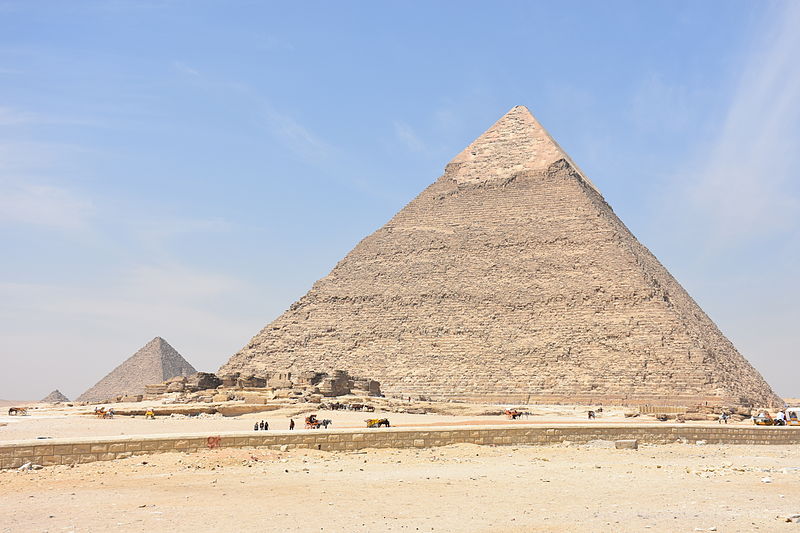
The Pyramid of Khafre, also known as the Second Pyramid of Giza, is Egypt’s second largest and most well-known pyramid. It was constructed approximately 2520 BCE for Pharaoh Khafre during the Fourth Dynasty of the Ancient Kingdom of Egypt.
The pyramid is part of a complex that includes the Great Sphinx and numerous lesser pyramids in Giza, on the outskirts of Cairo.
At a height of about 136 meters and a base of about 215 meters, the Pyramid of Khafre is smaller than the Great Pyramid of Giza. The pyramid is made of limestone rocks and has a stepped look, with each level being slightly smaller than the one below it.
Also Read: Famous Egyptologists
There are various chambers inside the pyramid, including the King’s Chamber, which is composed of red granite and has a gabled roof, similar to the King’s Chamber in the Great Pyramid. There is a subterranean room and the Queen’s Chamber is placed underneath the King’s Chamber.
The remaining casing stones that cover the uppermost portion of the Pyramid of Khafre are one of the pyramid’s most distinguishing features. These casing stones are constructed of high-quality limestone and were originally polished to a flawless finish, giving them a sparkling appearance in the sunlight.
The Pyramid of Khafre is famous for its astounding size and the perfection of its construction, as well as its location in the wider complex of Giza. It is still an important site for historians, archaeologists, and tourists, and it is one of Egypt’s most famous constructions.
3. Pyramid of Menkaure

The Pyramid of Menkaure is the smallest of the three major pyramids at Giza, Egypt, on the outskirts of Cairo. It was constructed approximately 2490 BCE for Pharaoh Menkaure during the Fourth Dynasty of the Old Kingdom of Egypt.
The pyramid stands around 65 meters tall and has a base of roughly 104 meters. It was constructed with limestone blocks and is surrounded by three smaller pyramids built for Menkaure’s wives.
There are three chambers inside the pyramid: the King’s Chamber, the Queen’s Chamber, and a subterranean chamber. The King’s Chamber is composed of red granite and has a gabled roof, like the King’s Chambers in Giza’s other two great pyramids.
Also Read: Ancient Egypt Facts
The remaining casing stones on the bottom half of the Pyramid of Menkaure are one of the pyramid’s distinguishing features. These stones were composed of high-quality limestone and were initially polished to a smooth sheen, which contrasted sharply with the rougher limestone blocks used for the rest of the pyramid.
The Menkaure Pyramid is renowned for its size and design, as well as its location inside the broader Giza complex. It is particularly notable for the varied inscriptions and graffiti left by visitors over the years, which provide significant insights on the pyramid’s history and use.
The Pyramid of Menkaure continues to be an important location for historians, archaeologists, and visitors, as well as a fascinating subject of research and exploration.
4. Step Pyramid of Djoser
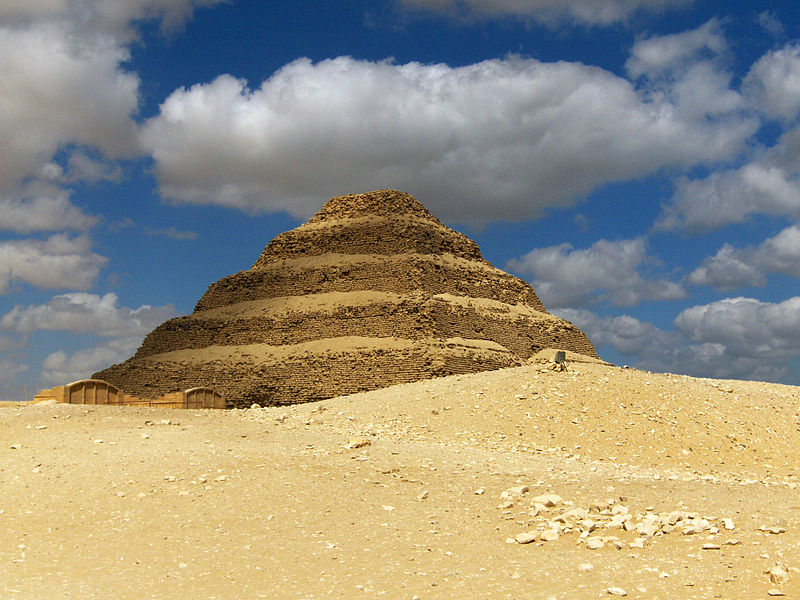
The Step Pyramid of Djoser, located in Saqqara, Egypt, is Egypt’s oldest pyramid and one of the world’s first examples of monumental stone masonry. It was constructed approximately 2630 BCE for Pharaoh Djoser during the Third Dynasty of the Old Kingdom of Egypt.
Imhotep, the legendary architect, created the pyramid, which originally stood roughly 62 meters tall with a base of approximately 125 meters. It is made up of six stacked mastabas, which are flat-roofed tombs.
The mastabas were eventually placed on top of each other to form the pyramid shape, which was the earliest known edifice of its kind.
Other constructions in the Step Pyramid complex include temples, courtyards, and other tombs. The Heb Sed court, which was used for jubilee festivities and is ornamented with elaborate reliefs, is one of the most remarkable structures.
The Step Pyramid contains a network of hallways and chambers, including the King’s Chamber, which houses a granite sarcophagus. The pyramid also has multiple shafts and galleries that were likely utilized for funeral rituals and ceremonies.
The Djoser Step Pyramid is famous for its distinct design, which marked a considerable change from preceding Egyptian tombs and established the standard for succeeding pyramids. It is particularly famous for its enormous scale and the skill required to construct such a complicated building during Egypt’s early civilization.
The Step Pyramid is still an important site for historians, archaeologists, and tourists, inspiring wonder and interest even today.
5. Bent Pyramid
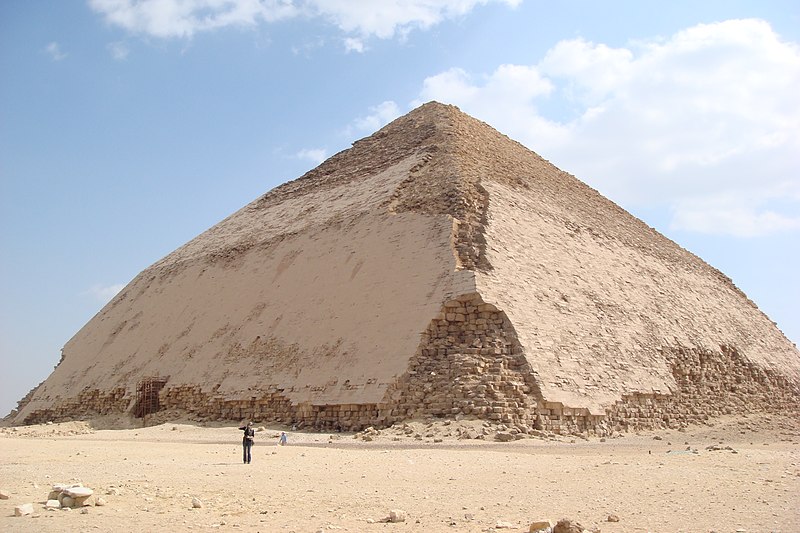
The Bent Pyramid is one of Egypt’s most remarkable and distinctive pyramids, found in Dahshur. It was constructed for Pharaoh Sneferu, who ruled in the 26th century BCE, during the Old Kingdom period of ancient Egypt.
The pyramid gets its name from its odd bent shape, which changes angle around midway up its height, giving it an ungainly and unbalanced appearance. The pyramid’s lower section was built at a steep angle of 54 degrees, whereas the upper section was built at a gentler inclination of 43 degrees.
The cause for this shift in angle is unknown, however the steep angle may have posed structural issues during construction.
The Bent Pyramid is composed of limestone and stands 105 meters tall with a base of 188 meters. It stands out due to its relatively undamaged outer casing of polished white limestone, which gives it a stunning and distinct aspect.
There are various chambers and passageways inside the Bent Pyramid, including the King’s Chamber, which has a pink granite sarcophagus. The pyramid also has a descending staircase that leads to an underground room that was likely utilized for funeral rituals and ceremonies.
Despite its odd shape and structural issues, the Bent Pyramid is regarded as a great engineering and design achievement. It is especially remarkable for its association with Sneferu, who was a prolific builder who oversaw the construction of several other notable structures during his reign.
The Bent Pyramid is still an important location for historians, archaeologists, and visitors, and it continues to pique people’s interest.
6. Red Pyramid
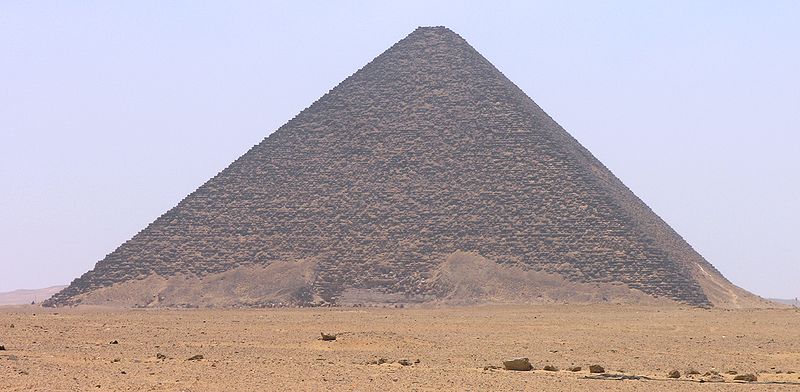
The Red Pyramid near Dahshur, Egypt, is one of Egypt’s best-preserved pyramids, famous for its striking red limestone masonry. It was constructed for Pharaoh Sneferu, who ruled in the 26th century BCE, during the Old Kingdom period of ancient Egypt.
The Red Pyramid, which stands roughly 104 meters tall and has a foundation of nearly 220 meters, is Egypt’s third-largest pyramid after the Great Pyramid of Giza and the Pyramid of Khafre.
It is particularly famous for its largely undamaged outside casing of smooth red limestone, giving it a stunning and unusual appearance.
There are various chambers and corridors inside the Red Pyramid, including the King’s Chamber, which has a red granite sarcophagus. The pyramid also has multiple galleries and shafts that were likely used for funeral rituals and ceremonies.
The Red Pyramid is regarded as an amazing engineering and design feat, noted for its comparatively basic and efficient construction procedures. It is especially remarkable for its link to Sneferu, who oversaw the construction of several other notable structures during his reign.
The Red Pyramid is still an important site for historians, archaeologists, and visitors, and it continues to pique people’s interest.
7. Pyramid of Amenemhat III
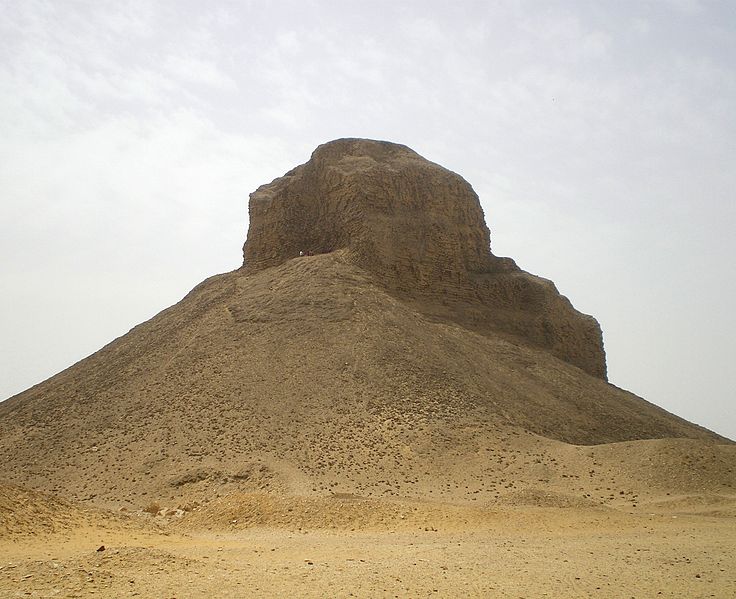
The Pyramid of Amenemhat III was erected during the Middle Kingdom period of ancient Egypt for Pharaoh Amenemhat III, who ruled around the 19th century BCE. It is located in Dahshur, Egypt.
The pyramid is 75 meters tall and has a base of nearly 105 meters. It is composed of mud brick and limestone. It is remarkable for its one-of-a-kind design, which incorporates a complicated internal structure with numerous rooms and corridors.
There are various passageways and chambers inside the pyramid, including the King’s Chamber, which has a red granite sarcophagus. Other rooms and corridors in the pyramid include a subterranean chamber and a mortuary temple.
The Pyramid of Amenemhat III is remarkable for its connection to Egypt’s Middle Kingdom period, which is regarded as a golden age of art, culture, and literature.
It is particularly notable for its diminutive size in comparison to the pyramids built during the Old Kingdom period, which demonstrates a shift in Egyptian monarchs’ priorities during this time period.
Despite its diminutive size and less intricate design in comparison to older pyramids, the Pyramid of Amenemhat III is an important site for historians, archaeologists, and tourists, providing unique insights into ancient Egypt’s history and culture.
8. Pyramid of Unas
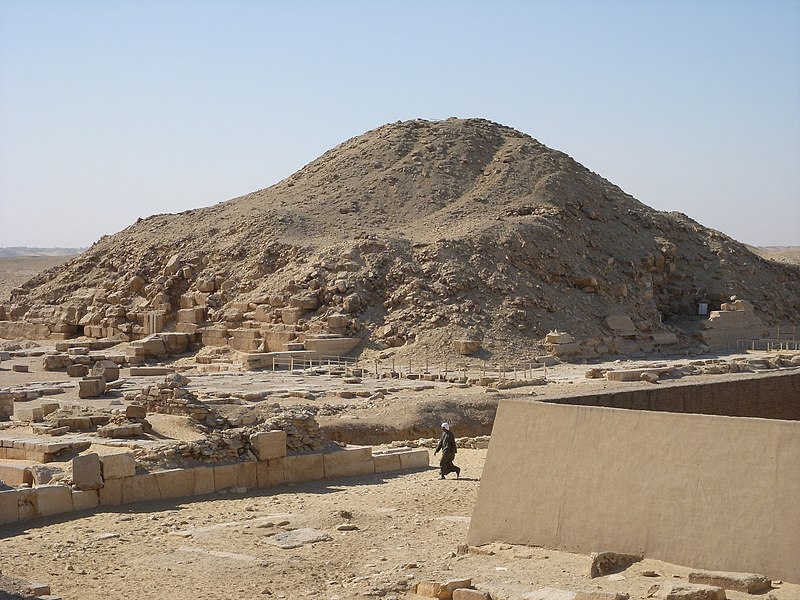
The Pyramid of Unas was built during the Fifth Dynasty of the Old Kingdom period of ancient Egypt for Pharaoh Unas, who ruled around the 24th century BCE. It is located near Saqqara, Egypt.
The pyramid is composed of limestone and stands about 43 meters tall with a 57-meter base. It is remarkable for its exquisite inside decorating, which includes the Pyramid Texts, a sequence of inscriptions that are among the world’s oldest known religious literature.
There are various chambers and passageways inside the pyramid, including the King’s Chamber, which has a pink granite sarcophagus. There are several further rooms and corridors in the pyramid, including a descending passage that leads to an underground chamber.
The Pyramid of Unas is renowned for its association with the Pyramid Texts, which were inscribed on the inner chamber walls of the pyramid and provided instructions and assistance for the pharaoh’s trip into the afterlife.
The texts are regarded as an important source of information on ancient Egyptian religion and beliefs, and their inclusion in the pyramid reflects the importance that religious rituals and beliefs were given throughout the Old Kingdom period.
Despite its tiny size in comparison to other pyramids, the Pyramid of Unas is an important site for historians, archaeologists, and tourists, providing unique insights into ancient Egypt’s history, culture, and religious beliefs.
9. Pyramid of Senusret II
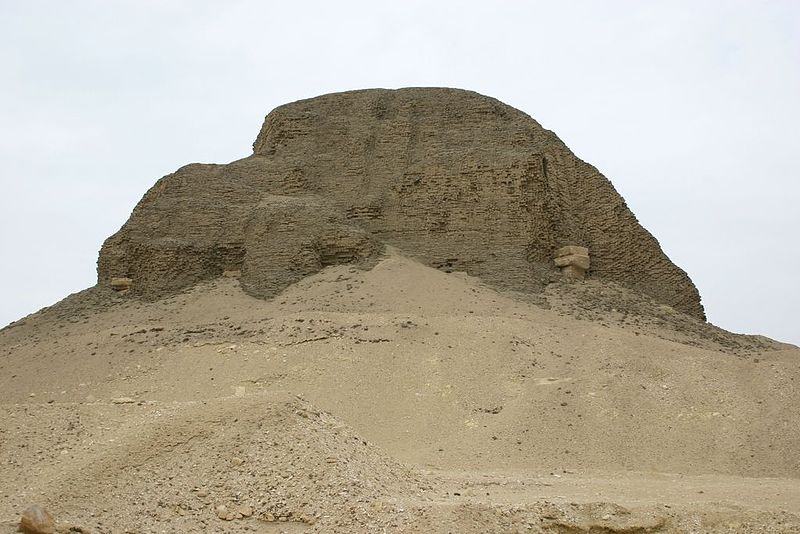
The Pyramid of Senusret II is located in Egypt’s Faiyum region and was built during the Twelfth Dynasty for Pharaoh Senusret II, who ruled during the nineteenth century BCE.
The pyramid is 48 meters tall and has a base of about 79 meters. It is composed of mud brick. It is remarkable for its one-of-a-kind design, which incorporates a complicated internal structure with numerous rooms and corridors.
There are various passageways and chambers inside the pyramid, including the King’s Chamber, which has a red granite sarcophagus. There are several further rooms and corridors in the pyramid, including a descending passage that leads to an underground chamber.
The Pyramid of Senusret II is remarkable for its connection to ancient Egypt’s Twelfth Dynasty, which is regarded as a period of stability and prosperity in Egyptian history.
It is particularly remarkable for its use of mud brick as a building material, which was less durable than the limestone used in earlier pyramids but allowed for more efficient and cost-effective construction.
Despite its tiny size and less intricate design compared to other pyramids, the Pyramid of Senusret II is an important site for historians, archaeologists, and tourists, providing unique insights into ancient Egypt’s history and culture during the Twelfth Dynasty.
10. Pyramid of Userkaf
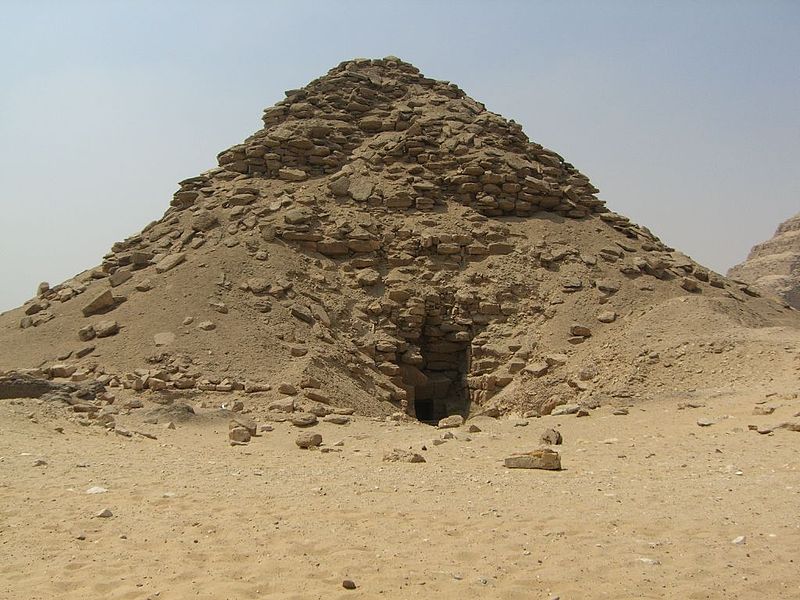
The Pyramid of Userkaf was erected during the Fifth Dynasty of ancient Egypt for Pharaoh Userkaf, who ruled in the 24th century BCE. It is located in Saqqara, Egypt.
The pyramid is formed of limestone and is rather tiny, with a height of roughly 49 meters and a base of around 73 meters. It stands out because to its location inside a wider complex of structures that includes several smaller pyramids and temples.
There are various chambers and passageways inside the pyramid, including the King’s Chamber, which has a red granite sarcophagus. There are several further rooms and corridors in the pyramid, including a descending passage that leads to an underground chamber.
The Pyramid of Userkaf is famous for its connection to ancient Egypt’s Fifth Dynasty, which is regarded as an era of significant cultural and aesthetic growth. It is particularly remarkable for its location inside the wider Saqqara complex, which demonstrates the growing importance of religious and ceremonial constructions during this time period.
Despite its relatively small size and less elaborate design compared to earlier pyramids, the Pyramid of Userkaf remains an important site for historians, archaeologists, and tourists, and provides valuable insights into the history, culture, and religious beliefs of ancient Egypt during the Fifth Dynasty.
11. Pyramid of Pepi II
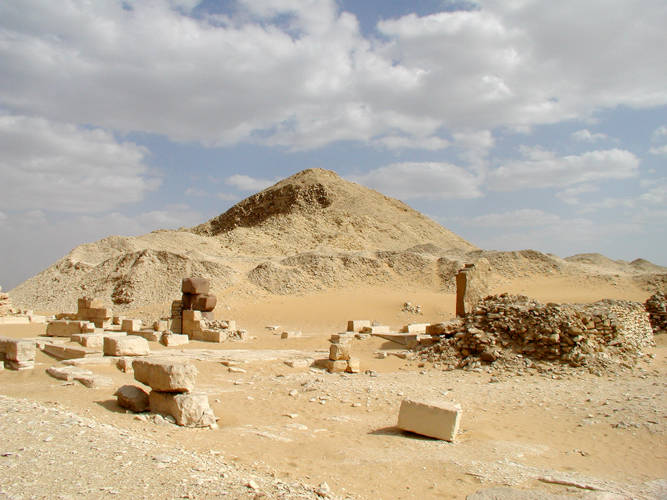
The Pyramid of Pepi II was built during the Sixth Dynasty of ancient Egypt for Pharaoh Pepi II, who ruled during the 23rd century BCE. It is located near Saqqara, Egypt.
The pyramid is composed of limestone and is quite tiny, standing about 21 meters tall and 78 meters wide. It is famous for its intricate internal construction, which contains multiple chambers and passageways, as well as its location within a larger building complex.
There are various rooms and corridors inside the pyramid, including a descending staircase that leads to an underground chamber. The pyramid also has various smaller rooms and constructions, such as a mortuary temple and pyramids for Pepi II’s wife and children.
The Pyramid of Pepi II is remarkable for its connection to ancient Egypt’s Sixth Dynasty, which is seen as an era of political and economic downfall. It is particularly remarkable for its location inside the greater Saqqara complex, which indicates the continued prominence of religious and ceremonial constructions during this time period.
Despite its smaller size and less ornate design in comparison to other pyramids, the Pyramid of Pepi II is an important site for historians, archaeologists, and tourists, providing unique insights into ancient Egypt’s history, culture, and religious beliefs during the Sixth Dynasty.
12. Pyramid of Teti
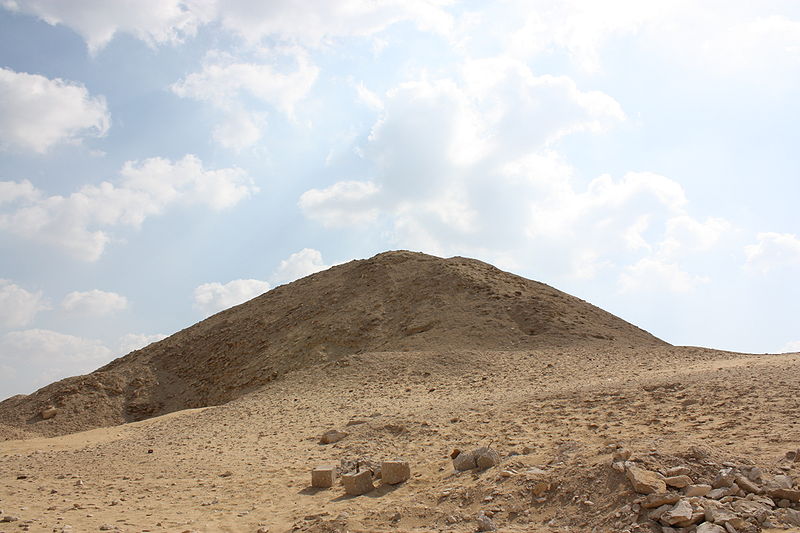
The Pyramid of Teti was built during the Sixth Dynasty of ancient Egypt for Pharaoh Teti, who ruled during the 23rd century BCE. It is located near Saqqara, Egypt.
The pyramid is composed of limestone and is roughly 52 meters tall, with a base of nearly 78 meters. It is noteworthy for its exquisite inside decorating, which includes the Pyramid Texts, a set of inscriptions identical to those found in the Pyramid of Unas.
There are various chambers and passageways inside the pyramid, including the King’s Chamber, which has a pink granite sarcophagus. There are several further rooms and corridors in the pyramid, including a descending passage that leads to an underground chamber.
The Pyramid of Teti is remarkable for its connection to ancient Egypt’s Sixth Dynasty, which is seen as an era of political and economic downfall. It is especially remarkable for its rich inside decoration, which provides significant insights into ancient Egyptian religious beliefs and rituals during this time period.
Despite its smaller size and less ornate design in comparison to other pyramids, the Pyramid of Teti is an important site for historians, archaeologists, and tourists, providing unique insights into ancient Egypt’s history, culture, and religious beliefs during the Sixth Dynasty.
13. Pyramid of Merenre

The Pyramid of Merenre was built during the Sixth Dynasty of ancient Egypt for Pharaoh Merenre, who ruled during the 23rd century BCE. It is located near Saqqara, Egypt.
The pyramid is composed of limestone and is very tiny, measuring 52 meters in height and 79 meters in width. It is famous for its distinct internal structure, which comprises a number of chambers and passageways.
There are various rooms and corridors inside the pyramid, including a descending staircase that leads to an underground chamber. There are also other smaller rooms and buildings in the pyramid, such as a mortuary temple and smaller pyramids for Merenre’s wives and children.
The Pyramid of Merenre is remarkable for its connection to ancient Egypt’s Sixth Dynasty, which is seen as an era of political and economic downfall. It is particularly renowned for its distinctive internal structure, which provides great insights into the architectural and engineering techniques used at the time.
Despite its tiny size and less intricate design compared to other pyramids, the Pyramid of Merenre is an important site for historians, archaeologists, and tourists, providing unique insights into ancient Egypt’s history, culture, and religious beliefs during the Sixth Dynasty.
